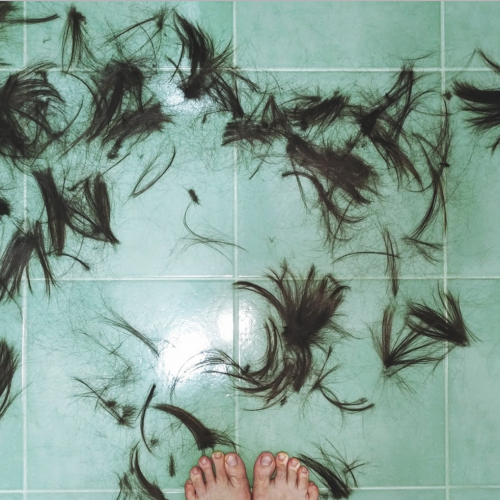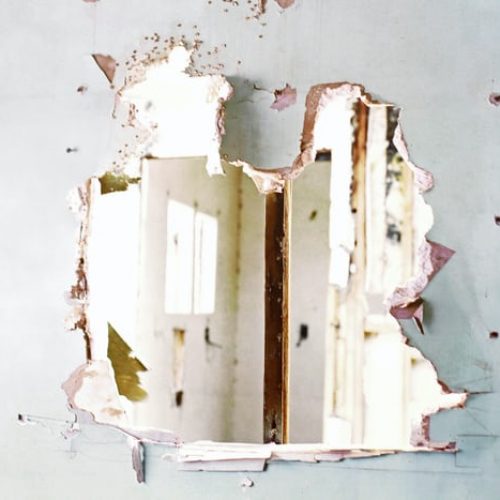I. Denial.
Some say it’s a Celtic thing. Others that I’m “kissed by nature.”
You’re blessed.
Special.
That mark is a stroke of luck.
Thick and unruly, the first gray hair stakes its claim when I’m 15. Socially anxious with acne to match, this leaves no place to hide.
My dark hair is a thicket, and the white emerges in sharp contrast, drawn hastily. Once it starts, the trickle turns to flood. Pale hairs fall into a pattern, claim space. Pale hairs create a streak above my right eye.
There are no prayers to turn the tide back.
Furtive, then, in the streaked mirrors of the high school bathroom where bolder girls crack windows to smoke. I push my face to glass and pull hairs out: plink. I pray that the junior girls don’t traipse in with their long, shimmering manes and easy laughter. Arranged in packs, their eyes narrow on vulnerability with precision. Constructed of sound, they are so blonde, so pretty, so thin. (At 15, we don’t know that shame is universal.)
These are alien creatures. The girls. The hairs.
I tug at them one day. Then the next.
Torn from scalp, the specimens stick to my hand, waxen follicles shining strange. Oblong, each is appended with an ant’s egg. If I don’t remove them, the hairs will hatch and grow back double. Drifting off, I picture bulbs pushing through skin in darkness.
Away from mirrors, occasional solace, my best friend and I run feral as if we’re able to stay young that way, lost on sandy trails between pines and tannic lakes. We shout into cloud-stamped sky outside of time and laugh open-throated.
II. Angry roots.
Gray is genetics but feels like metaphor.
Planted across 100,000 tear-shaped divots along the scalp, hair is fashion but also a binary, built with complex codes.
A single hair lives five to seven years, then drops like an autumn leaf, like fast-food trash thrown from car windows. Epidermal cells, or keratinocytes, are the builders. They stand atop one another to form a strand, to form a line, to form a chain. Neighboring melanocytes mix color, handing off art in small doses to render hue.
Only sometimes the program changes.
We say hair “goes” gray, but it doesn’t. Strands are color-fast, putting aside the imprint of chemicals or the sun. But the destiny of one doesn’t define the next. A replacement strand might be pale, color-giving melanocytes collapsed in exhaustion.
White hair arrives only after a death.
My gray is bone white, echoing the puffed-cloud curls of elderly aunts with Scottish and Irish accents. These women distanced themselves from a homeland marked by coal.
I pull my part tight against my scalp. Commune with spirits.
In old photos, the women wear black dresses and tepid smiles, hair curled and eyes weary. They’re Irish, but don’t wear history in freckles or reds, give or take an aberrant streak.
Our hair is midnight until the bottom drops out.
III. Bargaining with magic.
Sixteen, I spend hours wandering pharmacy aisles. A quest.
The formula for resurrection has been invented. It must be here.
I pick up a box. Stare at a woman older, but more youthful than me. Her elusive, spot-on shade will bring my darkness back to life.
At home, I pull on flimsy gloves, not sized for anyone’s hand. I twist the cap off the color gel—dark, almost purple—and pull acrid perfume into my lungs.
This is the scent of promise, a chemical stink.
Just a fingertip over the top and I shake decisively, shake gently, don’t shake too much. There is slight danger that this magic potion will explode.
Then: I root through my hair with careful intensity. I farm one row. Then the next. My biceps burn. This hair is thick. Frustrated, I smash the color through its heft in jagged lines and turn pink in the face.
Soon, this will all feel better. It’s important to mind the time, though, before a misstep becomes a stain. I pace. Sit tall on bed. The clear shower cap can’t contain the rivers that drip down my forehead, tattoo tears. In the eyes, color burns like rage and hope.
Just 25 minutes to go.
On the bathroom tile, paint-splatter marks go from violet to ash to permanence. Sometimes, I can scrub them out. Others leave splotches, no matter the scraping. Finally, into the shower. Relief.
Dye streaks down my bare body in torrents: Dark, then fading, then clear. I scrub my forehead with the good, cheap exfoliator made of walnut shells. I scrub it until the skin turns red and almost clean.
Dark hairs clustered around a swirling drain.
It is the circular motion of joy.
IV. Depression.
White roots march like an encroaching army.
This scene replays every five, four, three, two weeks.
White comes in thick.
It is mercenary.
White forgives little in the way of mistakes.
V. Accepting true tones.
The buzzer on the scalp is a massage. It is so delicious that it startles me when the power clicks on: Buzzzzz.
Presenting myself at a local salon—I repeat my request.
I want it shaved.
The stylist peers at me, eyes squinted below sea-blue hair. I can take you, she says, but in 30 minutes. She has seen this before. I can take you, but are you sure?
I drive circles on local highways, waiting for this purgatory to pass. The stylist assumes that I will not return, rescued from madness by her cunning. But I am prompt.
Seat me in your chair and set me free.
As the razor pushes deep into my chemically darkened waves, coal-tinged hair creates reverse snowdrifts on the floor. I kick my feet. A month after my fortieth birthday, I am the sound of girlish glee.
When I tell certain women this story, they squint and go searching.
They say: I wish I could.
They say: I would never.
They say: What did your husband think?

Jenn Hall
Marked by wanderlust, Jenn Hall lives and writes in Jersey. Her food writing has been honored by the International Association of Culinary Professionals, and she was a notable in Best American Food Writing 2019. Her essays and fiction have been published in Hippocampus Magazine, The Tishman Review, and Paste. Though driven to meander, she has come to learn that the best stories are hidden in plain sight. Follow along at jennhallwrites.com.





